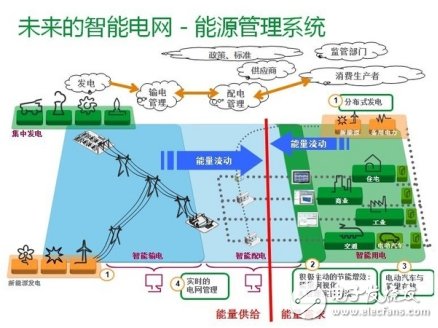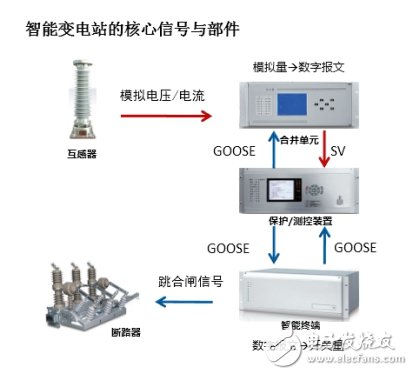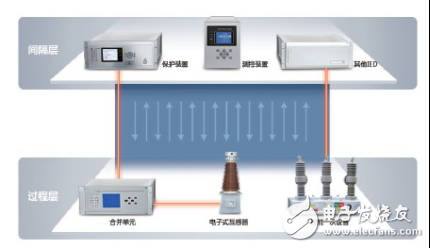As the development direction of the future power grid, the smart grid penetrates into various links such as power generation, transmission, substation, power distribution, power consumption, dispatching, and communication. In these links, the intelligent substation is undoubtedly the most important part, but how is the intelligent substation intelligent?
The smart grid is a new grid system that integrates modern information systems into traditional energy networks, so that the grid has better controllability and observability, and solves the problems of low energy utilization, poor interaction, and difficulty in analyzing safety and stability in traditional power systems. Thereby achieving the goal of reliable, safe, economical, efficient, environmentally friendly and safe use of the power grid.

As the development direction of the future power grid, the smart grid penetrates into various links such as power generation, transmission, substation, power distribution, power consumption, dispatching, and communication. In these links, the intelligent substation is undoubtedly the most important part.
The intelligent substation is built by intelligent primary equipment and networked secondary equipment. It is a modern substation that realizes information sharing and interoperability between intelligent electrical equipment in substations. Intelligent primary equipment mainly includes intelligent transformers, intelligent high-voltage switchgear, electronic transformers and so on. For example, the intelligent transformer and the control system are connected by communication fiber, and the transformer state parameters and operation data can be grasped in time.

On the basis of realizing the communication of primary equipment, the hierarchical construction of networked secondary equipment also needs a communication protocol with wide applicability and powerful functions, so that various devices can realize interoperability through protocols, so that the substation can be intelligently changed. As possible. This communication protocol is IEC61850. The IEC61850 standard realizes the standardization of engineering operation of intelligent substation, making the engineering implementation of intelligent substation standardized, unified and transparent. Through a series of normalization of the equipment, it forms a standardized output to achieve a seamless connection of the system.
1.2 Reliability of interoperability between various devicesSafety and reliability are always insurmountable principles of the grid system, and the equipment of many different manufacturers are connected together, and the reliability of interoperability between devices is also a difficult problem. In order to ensure the reliability operation and response speed of the entire intelligent substation system, it is necessary to rely on various tests and system joint adjustments during substation acceptance. Since the equipment of the intelligent substation is divided into three layers: the process layer, the interval layer and the station control layer, the acceptance of the intelligent substation should be based on the particularity of the intelligent substation, and the corresponding acceptance plan should be formulated at the time of acceptance. In general, the acceptance projects of intelligent substations mainly include project layer equipment acceptance, station control layer equipment acceptance and main system function acceptance.

As one of the most important tools for debugging and testing intelligent substation, DT6000 series intelligent substation optical digital tester can be used to protect the rapid test of monitoring and control devices, intelligent terminals, merging units, transformers and other equipment. The DT6000 series of optical digital testers integrate multiple functions into one, making it easy to complete the separation and control layer, process unit protection and control device, merging unit, transformer and optical power test, helping intelligent substation staff to verify the reliability of interoperability between various devices. .

RF Coaxial Connectors, commonly abbreviated as RF Coax Connectors, are specialized devices that play a pivotal role in facilitating the seamless transmission of radio frequency (RF) signals over coaxial cables. Their importance lies in ensuring reliable and efficient signal transfer across diverse communication systems, enabling seamless communication networks. Below is a comprehensive introduction to RF Coaxial Connectors, delving into their general characteristics, technical specifications, and widespread applications across various industries.
1. General Characteristics
Coaxial Design: RF Coaxial Connectors are designed to mate with coaxial cables, which consist of an inner conductor surrounded by an insulating material and an outer conductor (shield). This coaxial design helps minimize signal interference and ensures high-quality signal transmission.Impedance Matching: Most RF Coaxial Connectors are designed with a specific characteristic impedance, typically 50Ω or 75Ω, to match the impedance of the coaxial cable and the transmission line. This matching helps prevent signal reflections and maintains signal integrity.
Durability and Reliability: RF Coaxial Connectors are made from durable materials that can withstand various environmental conditions, including temperature fluctuations, humidity, and vibration. They are also designed for repeated connections and disconnections, ensuring long-term reliability.
2. Technical Specifications
Frequency Range: The frequency range supported by an RF Coaxial Connector depends on its design and materials. Some connectors are designed for low-frequency applications, while others can handle high-frequency signals up to several gigahertz (GHz).
Power Handling: Connectors have different power handling capabilities, ranging from low-power applications to high-power transmission systems.
Connection Mechanism: RF Coaxial Connectors come in various connection mechanisms, including bayonet (e.g., BNC), threaded (e.g., SMA, TNC, N-type), and push-on (e.g., MCX, MMCX). These different mechanisms offer varying levels of ease of use, durability, and performance.
3. Common Applications
Telecommunications: RF Coaxial Connectors are widely used in telecommunications infrastructure, including cellular networks, satellite communications, and microwave links.
Broadcasting: They are essential components in broadcasting systems, such as television and radio transmission, ensuring high-quality audio and video signals.
Test and Measurement: In test and measurement equipment, RF Coaxial Connectors are used to connect devices under test to measurement instruments, allowing for accurate and reliable measurements.
Military and Aerospace: Their durability and performance make RF Coaxial Connectors ideal for use in military and aerospace applications, including radar systems, missile guidance, and satellite communications.
Consumer Electronics: Many consumer electronics devices, including cable television set-top boxes, high-definition television (HDTV) receivers, and digital audio/video equipment, utilize RF Coaxial Connectors for signal input and output.
4. Key Advantages
High Signal Integrity: The coaxial design and impedance matching of RF Coaxial Connectors help maintain high signal integrity over long distances and in challenging environments.
Versatility: The wide range of connection mechanisms and frequency ranges supported by RF Coaxial Connectors makes them suitable for a variety of applications.
Durability and Reliability: Their durable construction and ability to withstand harsh conditions ensure long-term performance and reliability.
In summary, RF Coaxial Connectors are essential components in various communication systems, providing reliable and efficient transmission of radio frequency signals. Their coaxial design, impedance matching, and durable construction make them ideal for a wide range of applications, from telecommunications and broadcasting to military and consumer electronics.
N male and Female Connector,SMA male and Femal Connector,TS9 Connector,MCX Antenna,IPEX (MHF )Connector base
Yetnorson Antenna Co., Ltd. , https://www.yetnorson.com